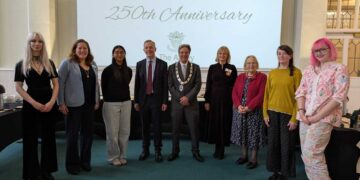A NEW pilgrims’ way that runs from Reading to Southampton and then on to Spain has been shortlisted for a major award.
The St James’ Way, has been put forward for the Best UK and Ireland Tourism Project at the British Guild of Travel Writers (BGTW) Awards.
The route retraces the steps of medieval pilgrims from the ruins of Reading Abbey to the south coast of England, from where pilgrims would have taken boats to Spain to complete their pilgrimage in Santiago de Compostela.
Today, almost half a million people walk one of the routes of the Camino de Santiago, including the Camino Inglés (the English Way) in Spain.
The St James’ Way, a new addition to the modern-day Camino de Santiago, begins at Reading’s medieval centre of pilgrimage, to which pilgrims would have beaten a path to see the Hand of St James and other Holy relics, before continuing along the Camino Inglés to Galicia in Spain.
The modern-day route is a long-distance walk of almost 70 miles which has been documented and waymarked by volunteers of the Confraternity of St James (CSJ) from Reading Abbey Ruins to God’s House Tower in Southampton via Bramley, the Upper Wield and Winchester Cathedral.
More than 400 scallop shell waymarking signs guide the walker along the route and the CSJ and REDA, Reading’s Economy and Destination Agency, has been heavily involved in helping with the creation of the new route.
As well as the scallop signs, walkers can also obtain a pilgrim passport and have it stamped at venues along the route – the first available in Reading Museum. A network of pilgrim accommodation is being developed and many pubs and cafes along the route are now able to stamp the pilgrim passports.
Reading has produced a useful guide to Reading for Modern Pilgrims to help walkers make the most of their time in Reading. From a handful of pilgrims two years ago, there is now a stream of walkers starting their pilgrimage in Reading.
And earlier this year, a mural was painted on the wall of Haslams, depicting Heather Small to commemorate her pilgrimage as seen on a BBC Two programme.
David Sinclair, lead CSJ Volunteer for the St James’ Way, said: “Camino pilgrimage revitalises the human spirit.
“This realisation drives CSJ volunteers in the Thames Valley and Hampshire to make the St James’ Way into a Camino of distinction, worthy of standing alongside the other renowned routes to Santiago, yet in a very English way.
“Recognition of these works, as they show signs of taking root, is pleasing to the Confraternity’s trustees, members and volunteers.
“More importantly, though, they hope, along with all our partners in this new tourism project, that it will lead to new waves of modern-day pilgrims who are proud to have discovered this Camino Inglés route in Southern England.”
And Alex Brannen, tourism lead for Reading, said: “With a growing interest in long-distance walking and the benefits of the outdoors, the development of the St James’ Way is very timely. It is a new tourism route based on a fascinating part of our history and we are seeing that it is already bringing new groups of visitors to our town and the wider area.
“The St James’ Way is now an accredited part of the Camino de Santiago, one of the world’s most famous walks, and we have to thank the amazing volunteers at the Confraternity of St James with support from colleagues in Galician tourism for helping create something so special.”
The winners will be announced at the BGTW Awards on Sunday, November 5.
More information on Reading for Modern Pilgrims at: www.visit-reading.com
More information on the St James’ Way at: www.csj.org.uk/st-james-way
























